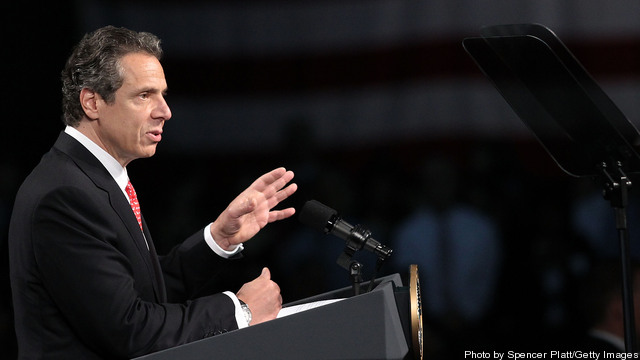 New York Gov. Andrew Cuomo
New York Gov. Andrew Cuomo
A reported plan by New York State government to allow natural gas drilling in a handful of counties may represent an effective lifting of the state’s moratorium on fracking but increases the chances that energy companies will run into local opposition, analysts said.
The New York Times reported Wednesday that the administration of Governor Andrew Cuomo is working on the plan that would limit fracking for natural gas primarily to five counties along the Pennsylvania border and allow local communities to make their own decisions on whether it can take place within their bounds.
In response to continuing accusations by fracking opponents that the controversial gas-extraction technique contaminates groundwater, the plan would also limit its use to deep areas of the Marcellus Shale, at least for several years, the report said.
Seeking Middle Ground in Fracking Debate
New York’s moratorium has been a thorn in the side of the gas industry that has been booming in neighboring Pennsylvania since 2008 and is eager to exploit the riches of the Marcellus on the north side of the border.
But public concern over the safety of the chemicals used in fracking has spawned strong local opposition in New York state, and prompted a lengthy examination of the issue by state environmental officials.
The counties where fracking could take place if approved by specific municipalities sit atop most of the technically recoverable gas in New York State, said Terry Engelder, a geosciences professor at Penn State University. Therefore, the proposed policy would effectively end the moratorium, he said.
“That’s going to cover way more than half of the gas that’s going to be recovered,” said Engelder, whose estimates of the amount of gas in the Marcellus helped to spark the drilling boom in Pennsylvania.
But the new policy, if implemented, would make life difficult for energy companies because they could be forced to deal with a “local hodge-podge” of regulations, Engelder said. That would contrast with a statewide standard, as applies in Pennsylvania, where a new law has reduced local control over the industry.
Sam Jaffe, research manager for IDC Energy Insights in Boulder, Colo., argued that the increased control given to local authorities is likely to mean the effective continuation of the moratorium because he said it’s easier to block industrial development at a local level than it is at the state level.
Who Benefits Most from New York’s Plan?
“This is a big win for the anti-fracking activists,” he said. “It would be a lot simpler to make the moratorium permanent.”
Jaffe predicted it will impact the debate in other states where governments are seeking a middle ground in the increasingly polarized debate between opponents and those who argue for the economic, environmental and energy-security benefits of natural gas.
As significant new shale reserves around the world transform the energy outlook, the International Energy Agency recently published guidelines for shale-gas development, urging operators to nurture public support by building wells to prevent leaks, disclosing the chemicals used in fracking, and treating water responsibly.
Travis Windle, a spokesman for the Marcellus Shale Coalition, a Pennsylvania-based industry group, said New York’s reported plans raise “more questions about the ongoing regulatory uncertainty in the state.” He urged the state to issue “common sense regulations” that allow the benefits of natural gas to be realized.
Deborah Goldberg, managing attorney for the environmental law group Earthjustice, welcomed the move to allow towns to make their own decisions on whether to allow fracking but said the state has yet to finalize environmental rules that would regulate the process in towns that permit it.
“There is a lot more that needs to be done,” she said.
Governor Cuomo’s office did not return calls seeking comment on the report.
